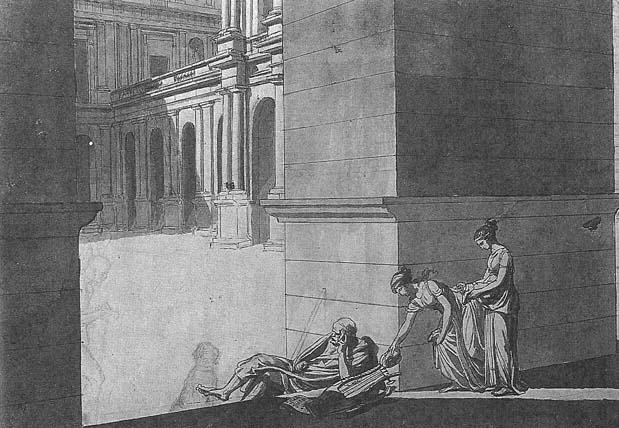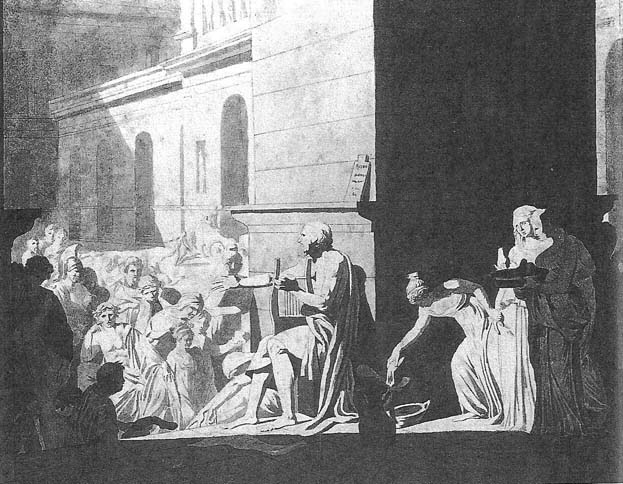
The idea of using Homer as the subject for Davidís pencil, pen, and ink wash drawings arose while he was in prison. ďThe Homer project was thus intimately involved in Davidís attempt to recast his artistic identity, which we have seen manifested in his self-representations from prison. Given the circumstances behind its conception, the meaning of the Homer project has to be considered in two interrelated aspects. First, we need to re-examine the function of the ancient bard as a wishful figure for David himself. Second, we need to consider the drawings as images of the creative processĒ (Necklines, 72-76).
RESTING HOMER By David

In this drawing, Homer is resting against the side of a building and appears in deep thought with his hand propped against his face. He is not even paying attention to the two women, who are paying him homage for his gift of song (shown by the lyre lying at his side). It almost feels like he is awaiting the crowd of people that will soon be showing up for his performance.
Barely distinct figures, hesitantly drawn in pencil, take shape in front of Homer; a silhouette of a dog seen from behind and an old man walking with a stick, this second figure perhaps another version, a sort of afterimage, of the figure of Homer himself, or else a member of his audience. The architecture of the courtyard strongly resembles that of Davidís prison, the Palais du Luxembourg. But its empty expanse also has a metaphoric dimension: it is an imaginary arena of the artistís vision, where a few sketchy figures barely hover, hesitant in acquiring their shape and meaning (Necklines, 80).
This drawing gives the feeling of incompleteness. One wonders why David only drew three main figures. If it to resemble the rest of the paintings that we have examined that include two women, then it is quite possible that the two women paying tribute to Homer are his two works, The Iliad and The Odyssey, yet nothing about them portrays this interpretation.
HOMER RECITING HIS VERSES TO THE GREEKS By David

This drawing depicts Homer making his living by performing to the masses. ďIn Reciting Homer, it is blindness, rather than thoughtfulness or dream, that connotes the artistís distance from immediate realityĒ (Necklines, 80). Homerís arm is extended forward towards his audience, calling forth to his audience.
In addition to the women and their offerings, also comprises Homerís manuscripts, lying at his feet, and, standing by the pillar on the left, in the place of the youth from Debretís version (See Drawing 3), an embracing male couple bathed in the shade, which stikes one as a harbinger of male affectionate interactions in Davidís later Leonidas at Thermopylae. Claimed by the darkness is also a wreathed male figure of the prompter at their feet, holding a scroll in his hands while looking up at Homer, as if verifying the bardís words (Necklines, 82).
The drawing shows how the epic poet made his living by the public giving him monetary gifts and by reciting his works to the public.